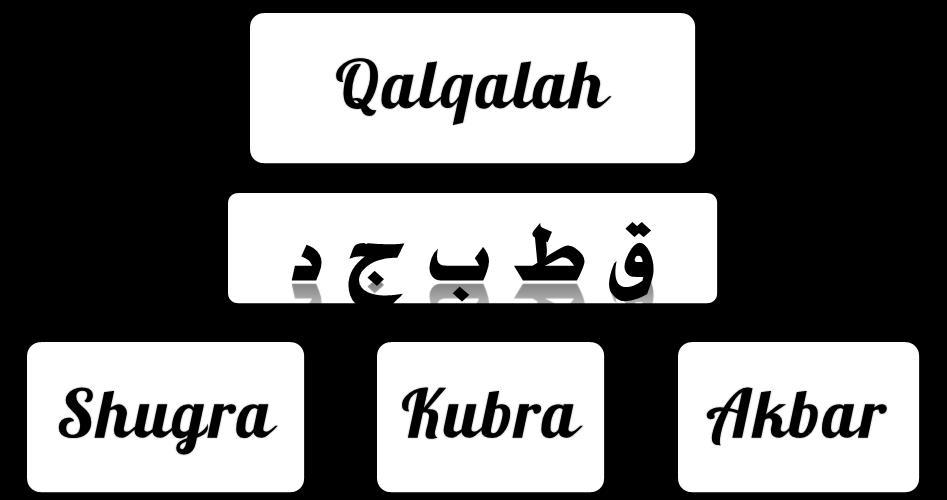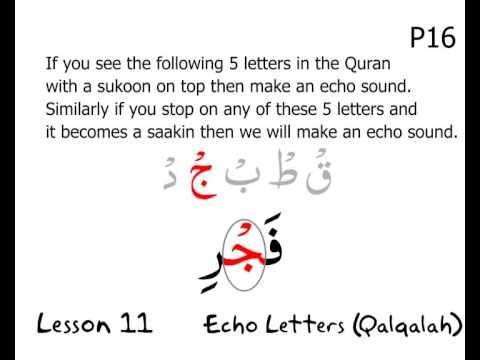Explore the fascinating world of the Qalqalah letters in this comprehensive course. The Qalqalah phenomenon is a crucial aspect of Arabic pronunciation, involving the unique echoing effect produced by certain letters. In this course, you will delve into the intricacies of the Qalqalah letters, mastering their pronunciation and understanding their impact on the rhythm and flow of Arabic speech.
Through interactive lessons and engaging exercises, you will learn to effortlessly incorporate the Qalqalah effect into your spoken Arabic, enhancing your fluency and command over the language. Whether you are a beginner or an advanced learner, this course will provide you with the knowledge and practice needed to utilize the Qalqalah letters in your Arabic communication confidently. Join us on this captivating journey and unlock the secrets of the Qalqalah letters for a truly authentic Arabic pronunciation experience.
What Is Qalqalah?
- Qalqalah is used in Arabic phonetics to describe a specific echoing or bouncing effect when pronouncing certain letters. The word “Qalqalah” itself means “echo” or “reverberation” in Arabic. When pronouncing specific letters, the effect is produced by a slight bouncing or vibration of the articulatory organs, primarily the tongue, palate, or throat.
- Five letters in the Arabic alphabet are classified as Qalqalah letters: ق (Qaf), ط (Taa), ب (Ba), ج (Jeem), and د (Dal). When any of these letters appear with sukoon (a diacritic indicating the absence of a vowel sound), a short vowel sound, or a shraddha (gemination mark), the Qalqalah effect occurs. The specific intensity of the effect varies depending on the position and context of the letter within a word.
- The Qalqalah effect adds a distinctive rhythm and resonance to Arabic speech. It is an important aspect of Arabic pronunciation and is particularly relevant in reciting the Quran, as proper understanding and application of Qalqalah are essential for correct recitation.
- Understanding the Qalqalah phenomenon and mastering its pronunciation is crucial for achieving accurate and fluent Arabic speech. It requires practice and attention to the specific articulatory movements involved in producing the effect.
- We offer you best way to learn arabic online through our website Arabian tongue
The Types Of Qalqalah

There are five main types of Qalqalah, each characterized by a specific set of letters. Let’s explore each type in detail:
Qalqalah Kubra (Major Echo)
Qalqalah Kubra occurs when one of the following letters is found at the end of a word or within a sentence: ق (Qaf), ط (Ta), ب (Ba), ج (Jeem), د (Dal). When pronounced, these letters produce a strong echoing effect. The Qalqalah Kubra is considered the most prominent type of Qalqalah.
Qalqalah Sughra (Minor Echo)
Qalqalah Sughra, also known as the minor echo, takes place when the following letters appear at the end of a word or within a sentence: ط (Ta), د (Dal), ج (Jeem), ب (Ba). The echoing effect produced by these letters is softer than the major echo but still contributes to the rhythmic flow of the language.
Qalqalah Wasat (Intermediate Echo)
Qalqalah Wasat, or the intermediate echo, occurs when one of the following letters is found at the end of a word or within a sentence: ذ (Dhāl), ز (Za), س (Seen), ص (Sād), ش (Sheen). These letters produce a moderate echoing effect, striking a balance between the major and minor echoes.
Qalqalah Wusta (Medium Echo)
Qalqalah Wusta, also known as the medium echo, is produced when the following letters are found at the end of a word or within a sentence: ف (Fa), ق (Qaf), ك (Kaf), ط (Ta), ب (Ba). The echoing effect created by these letters lies between the major and minor echoes, adding a pleasant cadence to the spoken words.
Qalqalah Sukhra (Subtle Echo)
Qalqalah Sukhra, the subtle echo, occurs when the letter ي (Ya) is found at the end of a word or within a sentence. It creates a subtle echoing effect, adding a delicate touch to the pronunciation. This type of Qalqalah is unique as it involves only one specific letter.
Significance of Qalqalah
Qalqalah plays a significant role in Arabic, contributing to its beauty, rhythm, and musicality. It enhances the poetic nature of Arabic poetry and is a fundamental aspect of Quranic recitation. By understanding and correctly applying Qalqalah, one can master the pronunciation of Arabic words and communicate more effectively.
Take a look at our course to Arabic grammar course online for beginners fluently
What Are The Letters Of Qalqalah?

The letters of Qalqalah are specific consonants in arabic grammar courses online that produce an echoing or reverberating effect when pronounced. There are five letters associated with Qalqalah:
- ق (Qaf)
- ط (Ta)
- ب (Ba)
- ج (Jeem)
- د (Dal)
These letters are part of the major Qalqalah group called Qalqalah Kubra. When any of these letters appear at the end of a word or within a sentence, they create a pronounced echo in the pronunciation. It adds a rhythmic and musical quality to the spoken Arabic language. Additionally, there are other letters associated with different types of Qalqalah:
Qalqalah Sughra (Minor Echo):
-
- ط (Ta)
- د (Dal)
- ج (Jeem)
- ب (Ba)
Qalqalah Wasat (Intermediate Echo):
-
- ذ (Dhāl)
- ز (Za)
- س (Seen)
- ص (Sād)
- ش (Sheen)
Qalqalah Wusta (Medium Echo):
-
- ف (Fa)
- ق (Qaf)
- ك (Kaf)
- ط (Ta)
- ب (Ba)
Qalqalah Sukhra (Subtle Echo):
-
- ي (Ya)
Each type of Qalqalah produces a distinct level of echo or reverberation when pronounced, contributing to the overall beauty and rhythm of the Arabic language.
Why Is Qalqalah Important?

Qalqalah holds significant importance in the Arabic language for several reasons. Here are some key reasons why Qalqalah is important:
Phonetic Distinction:
Qalqalah helps differentiate Arabic letters and adds a unique sound quality. It provides a distinct echo or reverberation effect, allowing listeners to distinguish between similar-sounding letters. This phonetic distinction is crucial for accurate pronunciation and understanding of tips for learning Arabic words.
Rhythmic Flow:
Qalqalah contributes to the rhythmic flow of Arabic speech. The echoing effect created by Qalqalah letters adds musicality and cadence to the language, making it captivating and pleasing to the ear. It enhances Arabic poetry’s and traditional recitation’s poetic nature, creating a harmonious and melodic delivery.
Quranic Recitation:
Qalqalah plays a vital role in the recitation of the Quran. The Quran, the holy book of Islam, is traditionally recited with specific rules and pronunciation techniques. Qalqalah is one of these rules, and its proper application ensures the accurate and melodious recitation of the Quran. Mastering Qalqalah is essential for those who recite the Quran or deeply appreciate its recitation.
Cultural Significance:
Qalqalah is deeply rooted in Arabic culture and heritage. It has been an integral part of the language for centuries and is valued for its artistic and expressive qualities. Qalqalah adds a touch of elegance and sophistication to the spoken word, reflecting the rich cultural heritage of Arabic-speaking communities.
Language Mastery:
Understanding and correctly applying Qalqalah is a sign of language mastery in Arabic. It demonstrates a deeper knowledge of phonetics, pronunciation, and subtle nuances. By mastering Qalqalah, individuals can communicate more effectively, convey emotions, and appreciate the beauty of the Arabic Language Kids Course and poetry.
Common questions:
What are Qalqalah letters in the Arabic language?
Qalqalah letters are specific consonants in Arabic that produce an echoing or reverberating effect when pronounced. They include ق (Qaf), ط (Ta), ب (Ba), ج (Jeem), and د (Dal).
How many types of Qalqalah are there?
There are five types of Qalqalah: Qalqalah Kubra (major echo), Qalqalah Sughra (little echo), Qalqalah Wasat (intermediate echo), Qalqalah Wusta (medium echo), and Qalqalah Sukhra (subtle echo).
What is the difference between major and minor Qalqalah?
Major Qalqalah (Qalqalah Kubra) is produced by ق, ط, ب, ج, and د, and it creates a strong echoing effect. Minor Qalqalah (Qalqalah Sughra) is produced by ط, د, ج, and ب, and it produces a softer echoing effect compared to the major echo.
Which letters are associated with intermediate Qalqalah?
Intermediate Qalqalah (Qalqalah Wasat) involves the letters ذ (Dhāl), ز (Za), س (Seen), ص (Sād), and ش (Sheen). These letters produce a moderate echoing effect.
Which letters create a medium Qalqalah?
Medium Qalqalah (Qalqalah Wusta) is produced by the letters ف (Fa), ق (Qaf), ك (Kaf), ط (Ta), and ب (Ba). It lies between the major and minor echoes regarding the echoing effect.
What is the subtle Qalqalah?
Subtle Qalqalah (Qalqalah Sukhra) is produced by the letter ي (Ya) when it appears at the end of a word or within a sentence. It creates a delicate and subtle echoing effect.
In summary
Qalqalah is important in the Arabic language due to its role in phonetic distinction, rhythmic flow, Quranic recitation, cultural significance, and language mastery. It enhances the beauty and expressiveness of Arabic speech, making it a vital aspect of the language’s rich linguistic and cultural heritage.


